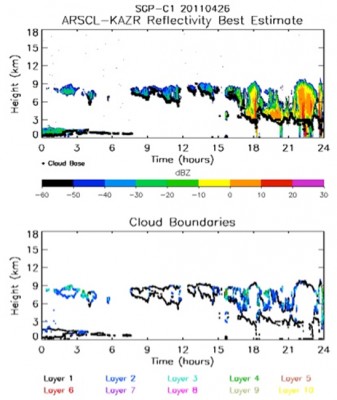
KAZR observations in this VAP are corrected for water vapor attenuation and velocity aliasing, and then significant detection masks are produced. Water vapor attenuation refers to radar signal power loss due to absorption of the signal by water vapor. Velocity aliasing corrections exclude velocities measured by the radars that are outside the radar’s accurate detection range.
The corrected KAZR measurements are combined with observations from the micropulse lidar, ceilometer, balloon-borne radiosondes, rain gauge, and microwave radiometer to produce two datastreams: one with cloud base and cloud-layer boundaries, and one that also includes best-estimate time-height fields of radar moments.
KAZR-ARSCL evaluation data are available for the ARM Southern Great Plains site during the Midlatitude Continental Convective Clouds Experiment (MC3E), April to June 2011. Evaluation data are also available for the ARM Mobile Facility deployment at Gan Island, Maldives, for the ARM MJO Investigation Experiment (AMIE) from October 2011 to February 2012.
Additional information is available in the README file that accompanies the data files from the ARM Data Archive. Please send any comments and suggestions related to the product to Karen Johnson, kjohnson@bnl.gov. This feedback will assist in improving the product prior to its full release.
More information on the VAP is available at the product web page. To access these data, log in to the Data Archive. (Go here to request an account.)

